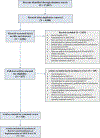A Scoping Review of Barriers and Facilitators to Implementation of Medications for Treatment of Opioid Use Disorder within the Criminal Justice System
- PMID: 32446130
- PMCID: PMC8372195
- DOI: 10.1016/j.drugpo.2020.102768
A Scoping Review of Barriers and Facilitators to Implementation of Medications for Treatment of Opioid Use Disorder within the Criminal Justice System
Abstract
Background: Policies aimed at addressing the high rates of opioid overdose have prioritized increasing access to medications for treatment of opioid use disorder (MOUD). Numerous barriers exist to providing MOUD within the criminal justice system and/or to justice-involved populations. The aim of this study was to conduct a scoping review of the peer-reviewed literature on implementation of MOUD within criminal justice settings and with justice-involved populations.
Methods: A systematic search process identified 53 papers that addressed issues pertaining to implementation barriers or facilitators of MOUD within correctional settings or with justice-involved populations; these were coded and qualitatively analyzed for common themes.
Results: Over half of the papers were published outside of the U.S. (n = 28); the most common study designs were surveys or structured interviews (n = 20) and qualitative interviews/focus groups (n = 18) conducted with correctional or treatment staff and with incarcerated individuals. Four categories of barriers and facilitators were identified: institutional, programmatic, attitudinal, and systemic. Institutional barriers typically limited capacity to provide MOUD to justice-involved individuals, which led to programmatic practices in which MOUD was not implemented following clinical guidelines, often resulting in forcible withdrawal or inadequate treatment. These programmatic practices commonly led to aversive experiences among justice-involved individuals, who consequently espoused negative attitudes about MOUD and were reluctant to seek treatment with MOUD following their release to the community. Facilitators of MOUD implementation included increased knowledge and information from training interventions and favorable prior experiences with individuals being treated with MOUD among correctional and treatment staff. Few systemic facilitators to implementing MOUD with justice-involved individuals were evident in the literature.
Conclusion: Barriers to implementing MOUD in criminal justice settings and/or with justice-involved populations are pervasive, multi-leveled, and inter-dependent. More work is needed on facilitators of MOUD implementation.
Keywords: barriers; criminal justice system; facilitators; implementation; medication; opioid use disorder.
Copyright © 2020 Elsevier B.V. All rights reserved.
Similar articles
-
Barriers and facilitators to the use of medication for opioid use disorder within the criminal justice system: Perspectives from clinicians.J Subst Use Addict Treat. 2023 Jun;149:209051. doi: 10.1016/j.josat.2023.209051. Epub 2023 Apr 19. J Subst Use Addict Treat. 2023. PMID: 37084815 Free PMC article.
-
Massachusetts Justice Community Opioid Innovation Network (MassJCOIN).J Subst Abuse Treat. 2021 Sep;128:108275. doi: 10.1016/j.jsat.2021.108275. Epub 2021 Jan 8. J Subst Abuse Treat. 2021. PMID: 33483222 Free PMC article.
-
A national survey of barriers and facilitators to medications for opioid use disorder among legal-involved veterans in the Veterans Health Administration.Subst Abus. 2022;43(1):556-563. doi: 10.1080/08897077.2021.1975867. Epub 2021 Sep 29. Subst Abus. 2022. PMID: 34586978 Free PMC article.
-
A scoping review of factors that influence opioid overdose prevention for justice-involved populations.Subst Abuse Treat Prev Policy. 2021 Feb 22;16(1):19. doi: 10.1186/s13011-021-00346-1. Subst Abuse Treat Prev Policy. 2021. PMID: 33618744 Free PMC article.
-
Impact of summer programmes on the outcomes of disadvantaged or 'at risk' young people: A systematic review.Campbell Syst Rev. 2024 Jun 13;20(2):e1406. doi: 10.1002/cl2.1406. eCollection 2024 Jun. Campbell Syst Rev. 2024. PMID: 38873396 Free PMC article. Review.
Cited by
-
Barriers and Facilitators to Substance Use Disorder Treatment: An Overview of Systematic Reviews.Subst Abuse. 2022 Aug 29;16:11782218221118462. doi: 10.1177/11782218221118462. eCollection 2022. Subst Abuse. 2022. PMID: 36062252 Free PMC article. Review.
-
Referral to and engagement in substance use disorder treatment within opioid intervention courts in New York: a qualitative study of implementation barriers and facilitators.Subst Abuse Treat Prev Policy. 2024 Jan 29;19(1):12. doi: 10.1186/s13011-024-00593-y. Subst Abuse Treat Prev Policy. 2024. PMID: 38287329 Free PMC article.
-
Facilitating factors and barriers for use of medications to treat opioid use disorder (MOUD) among justice-involved individuals in rural Appalachia.J Community Psychol. 2024 Nov;52(8):997-1014. doi: 10.1002/jcop.23029. Epub 2023 Mar 17. J Community Psychol. 2024. PMID: 36930568
-
Legislatively mandated implementation of medications for opioid use disorders in jails: A qualitative study of clinical, correctional, and jail administrator perspectives.Drug Alcohol Depend. 2022 May 1;234:109394. doi: 10.1016/j.drugalcdep.2022.109394. Epub 2022 Mar 7. Drug Alcohol Depend. 2022. PMID: 35349918 Free PMC article.
-
Switching of opioid agonist treatment modality during imprisonment: A novel marker for increased support need during and following release from prison.Int J Drug Policy. 2022 Feb;100:103572. doi: 10.1016/j.drugpo.2021.103572. Epub 2022 Jan 5. Int J Drug Policy. 2022. PMID: 34998045 Free PMC article. No abstract available.
References
-
- American Society of Addiction Medicine. (2020). ASAM National Practice Guideline for the Treatment of Opioid Use Disorder. Rockville, MD: Author.
-
- Arksey H. & O’Malley L. (2005) Scoping studies: Towards a methodological framework, International Journal of Social Research Methodology, 8 (1), 19–32.
Publication types
MeSH terms
Grants and funding
LinkOut - more resources
Full Text Sources
Medical


